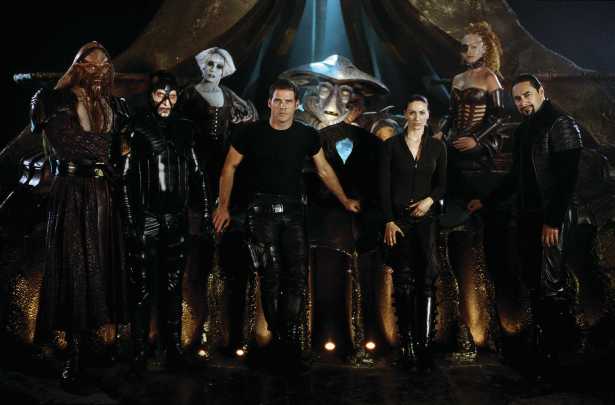
Imagine you’re an astronaut. You’re on a ground-breaking but completely safe experiment. Except that things go awry and you find yourself on the other edge of the universe with no way to get back home, and you’re stuck on a sentient ship with aliens who would just as rather kill you than talk to you. That’s the life of Farscape protagonist John Crichton.
That’s what makes good television.
There’s a lot of things that made Farscape a gem of the science fiction community, but first and foremost are the chemistry between the actors. Just watching one episode tells you that these people aren’t really acting: they’re best friends. The initial tension and its evolution into friendship (and beyond) is a parallel of the comradery these people have in real life. Its authenticity is what brought fans coming back for more.
Farscape also had the distinct gimmick of letting its villains stretch their muscles. Each Farscape season had a primary antagonist, and each succeeding season had that villain become part of the crew. Even Scorpius, the malignant alien whose passion for torturing and hunting down John Crichton was legendary, had a turn at the ally table. It’s nothing new; most soap operas thrive on the ever-shifting quagmire of allies and enemies. But no show – science fiction or no – has managed to capture it the way Farscape has.
Of course it doesn’t hurt that Farscape had some of the most ambitious plot arcs to date. Scorpius did more than just torture Crichton. He put a miniscule version of himself inside Crichton’s head. The entire second season deals with Crichton and his split personality “Harvey.” Actors Ben Browder and Wayne Pygram (Crichton and Scorpius respectively) did more than the good guy/bad guy buddy arc going. They literally brought the best out of each other. They literally were in one another’s skins.
Then of course there’s the clone plot. Every person on Moya – the aforementioned sentient ship – gets cloned. But John Crichton’s clone survives. This leads to a bit of tug-of-war between the two as they try to establish their identities in ways no other person struggled. But the real beauty of this idea shines with the main characters separate. One Crichton – hereon referred to as Blue-Shirt Crichton – leaves Moya with Aeryn Sun (Crichton’s love interest) while the other – hereon referred to Green-Shirt Crichton – stays on Moya. The two have different adventures and develop in different ways, but both are distinctly John Crichton.
So eventually the inevitable happens: Aeryn and Blue Shirt Crichton hook up, but fate is never kind in these situations. Blue Shirt dies in Aeryn’s arms. So when Green-Shirt Crichton reunites with Aeryn, things are naturally frosty. It takes a lot of episodes for Aeryn to realize that she loves John Crichton the person.
This relationship could have easily gone awry in any number of ways. Certainly the rulebook concerning the on-again/off-again romantic relationship has never been tested like this. But again, its success falls upon the strength and chemistry of the actors involved. Ben Browder and Claudia Black are magic together. Finding a balance between two completely different characters is difficult at best, but they pull it off flawlessly. Every scene they share bursts with genuine emotion.
Science fiction has always been a hot-bed of creativity. The best shows, however, rely on the characters’ relationships to support the stories. Farscape exceeds the concept in fantastic ways. You can feel the love between this mismatched family because that’s what they are: family. One episode, and you’ll be hooked.
Have I ever let you down?